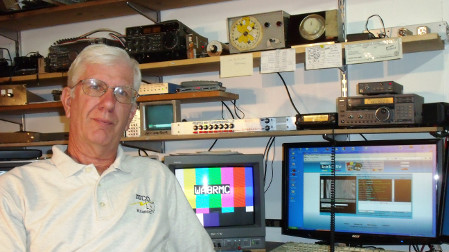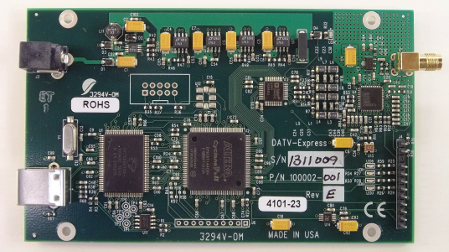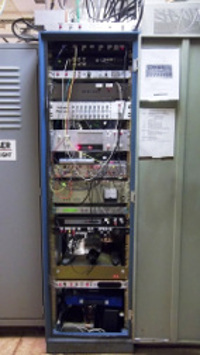Amateur Radio Operators Convert to Digital Television
ALEXANDRIA, VA.—Radio amateurs, or “hams,” have been involved in one way or another with television practically ever since commercial entities began developmental work in the medium during the 1920s. And many TV engineers have held ham licenses and performed their own share of experimental work in their off-duty hours. Early on, at least one manufacturer offered camera pickup tubes at discounted prices to encourage experimentation by the radio amateur community.
Ham TV has evolved right along with the rest of the industry, moving from mechanical scanning to all-electronic operation, then color, and eventually to digital video and most recently, high-definition imaging. And while commercial television entities have routinely spent hundreds of thousands of dollars in retrofitting analog plants for digital broadcasting, hams—being an ingenious and creative lot—have managed to go digital on the cheap.

Art Towslee
Art Towslee (amateur station call sign WA8RMC) is one of these DTV pioneers. He’s now 74 and a retired Ohio electrical engineer who once specialized in the design of industrial weighing equipment. His interest in both ham radio and television date back to the mid-1960s.
“A bunch of guys I knew were playing with some war surplus UHF radio gear and actually using it to transmit video,” said Towslee. “I became very interested and got my ham license in 1965.”
For the past 50 years, Towslee has continued to experiment with television transmission in the amateur radio spectrum—they are assigned chunks of RF real estate in the UHF and higher frequency bands for such work—and a few years ago, along with other members of his Columbus-area amateur radio club, transitioned to digital video, becoming the first such group in the U.S. to do so.
“Our club, ATCO [Amateur Television in Central Ohio], was formed in 1989,” Towslee said. “We established a video-capable repeater [a “translator” with elevated receive and transmit antennas used to increase the range of amateur radio transmissions] in 1994 and used it to relay analog video transmissions between club members. Later on I had heard of some European amateurs who were experimenting with digital television and said ‘wouldn’t it be wonderful’ if we could do that here.”
Get the TV Tech Newsletter
The professional video industry's #1 source for news, trends and product and tech information. Sign up below.
Towslee, who is president of ATCO and publishes the club’s newsletter, did some investigation and eventually located an engineer in the Netherlands who had designed a digital video encoder/decoder board set and was now marketing these. The price selling tag was in the $1,000 range and they were designed for the DVB-S (satellite) standard. Towslee and his group purchased the encoder in 2003 and installed it at their repeater site to provide a channel with digital video transmission capability.
FIRST ON THE BLOCK WITH AMATEUR DTV
“We were first in the U.S. to have digital amateur TV capability,” Towslee said. “We claim bragging rights.”
He explained that the card set (MPEG compression and DVB-S modulator) was fed incoming analog video and its RF output was coupled to an amplifier operating in the amateur service 23 centimeter band (1,240-1,300 MHz). The club made a group buy of “free-to-air” digital satellite receivers that decoded DVB-S and soon some 20 Ohio ham operators were exchanging digital television images.
“We added DVB-S receive capability to the repeater around 2010—DTV in/DTV/out,” said Towslee. “This made us the first amateur radio group in the country with full digital repeater operation.”

The $300 DATV Express digital television board developed by the ATCO amateur radio group
Towslee admits that interest in the digital video operation has dwindled a bit in the past five years (“you get bored seeing the same things over and over”), but says that some of the digital devotees are still at it.
“We now have two digital channels at our repeater,” he said. “One in the 23-centimeter band at 1,268 MHz and another in the 70-centimeter band on 423 MHz. The 23-centimeter is set up to operate in 3.5 MHz of bandwidth and the 70-centimeter uses only 2 MHz.”
MADE IN THE USA
In an effort to make DTV more accessible for amateur radio operators, Towslee, along with two others, has launched a small manufacturing operation that produces a digital encoder card—the DATV (Digital Amateur TV) Express board—that sells for $300. It operates in conjunction with a PC, as it’s a software-defined device, and provides either a DVB-S or -T output.
“Our purpose was to get people in the U.S. interested in DTV,” said Towslee. “So far we’ve sold 120 of the cards. However, I am a little disappointed as most of the sales have been to people in Japan and Europe.”
When asked about the sort of experimentation hams are doing with their digital video gear, Towslee said that “d-xing” or attempting to cover long distances with fairly low power is one of these.

This rack contains the workings of the Columbus, Ohio amateur radio television repeater system. The digital processing gear is in the box atop the rack.
“Using DVB-S we’ve achieved about 100 miles,” he said. “With DVB-T and operating on 423 MHz one person in our group has done over 500 miles running about 400 Watts EIRP; of course this was over some pretty flat Ohio country.”
When asked if any of his DTV group had attempted high-definition operations, Towslee stated that all operations were still being done in 480-line SD; however, he added that the DATV Express could be upgraded for HDTV operation.
“The board is absolutely HD-capable,” said Towslee. “If there is a demand we will write code for HD operation.”
Continued at “Ham TV Operators Go HD.”
